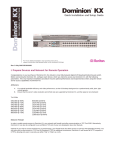Download KX101 Quick Installation and Setup Guide
Transcript
® Dominion KX101 Quick Installation and Setup Guide II. Connect to Network and Attach to Server (cont) 4. If not using Power over Ethernet (PoE), connect the included AC power adptor kit into the Power Port and plug the other end into a nearby AC power outlet. KX101 unit with USB pigtail 5. The LAN LED indicates Ethernet activity and blinks while the KX101 is in use. KX101 unit with PS2 pigtail Congratulations on your purchase of Dominion KX101. KX101 provides a single KVM port for connection to a target server and a single IP port for connection to an IP network. Control the KX101 via Raritan’s CommandCenter (v. 2.2 and above) or independently via Raritan’s KX Manager and RRC management software platforms. Before installing KX101, configure any target servers that you wish to access with it as outlined below. A. For optimal bandwidth efficiency and video performance, set the OS desktop background to a predominantly solid, plain, light-colored graphic. B. Ensure that the server’s video resolution and refresh rate are supported by KX101, and the signal is non-interlaced: Text Mode 640x480@60Hz 640x480@72Hz 640x480@75Hz 640x480@85Hz 800x600@60Hz 800x600@72Hz 800x600@75Hz 800x600@85Hz 1280x1024@60Hz 1024x768@60Hz 1024x768@70Hz 1024x768@75Hz 1024x768@85Hz 1152x864@60Hz 1152x864@75Hz 1600x1200@60Hz Network / Firewall In order to enable remote access to KX101, your network and firewall must allow communication on TCP Port 5000. Alternatively, KX101 can also be configured to use a different TCP port of your own designation (see User Manual). Optional: If you wish to access KX101 via web browser, your firewall must also allow access to TCP Port 443 (Standard HTTPS). You may also wish to allow access to TCP Port 80 (Standard HTTP) for additional convenience; KX101 will forward all HTTP requests to HTTPS, allowing end users to securely use either “http” or “https” as a URL. Windows XP Disable “Enhanced pointer precision”, and set the mouse motion speed exactly to the middle speed setting. These options are located in Control Panel > Mouse > Pointer Options. Disable transition effects in Control Panel > Display > Appearance > Effects. Windows 2000 Set mouse pointer acceleration to “None” and the mouse motion speed exactly to the middle speed setting. Disable transition effects in Control Panel > Display > Effects. If 5 3 6 6. When powered up, the KX101 goes through an initial I. Prepare Devices and Network for Remote Operation All Servers 4 boot-up sequence. During this sequence, the blue Raritan light blinks. When boot-up has completed, the blinking stops and the KX101 is operational. You may want to connect the KVM cable to the appropriate KVM ports of the target server and proceed to section III. Initial Configuration. in Intelligent or Absolute (USB only) Mouse Synchronization Mode, acceleration is supported. Linux (with Desktop) Graphical For optimal results, set mouse acceleration to exactly 1, and threshold to exactly 1. Sun Solaris (with Graphical Desktop) For optimal results, set mouse acceleration to exactly 1.0. Also, be sure that your video card is set to a supported resolution and is outputting VGA (H-and-V Sync, not composite sync). This nondefault configuration can be set in the bootprom mode by issuing the command: setenv output-device screen : r1024x768x70 Then issue the “boot” command to reboot. III. Initial Configuration Initial configuration of the KX101 is performed via the local administration port. To connect to this port, plug one end of the RJ11 cable included in the KX101 kit into the ADMIN port on the unit. Plug the other end of the cable into the serial port of a PC using the serial-to-RJ11 adaptor provided. On the PC, access the serial port with a terminal emulation program (e.g., Hyper Terminal) using the following settings: 9600 baud, 8 data bits, no parity, one stop bit, and no flow control. Pressing the “Enter” key in the terminal emulation program displays the KX101 Login screen. Enter the default password “raritan” and the Main Menu of the KX101 administrative interface is displayed. Follow the on-screen instructions to navigate the menus. Select Network Configuration (Figure 1) and configure these settings (Figure 2). 1. Name: Type a unique name for the KX101, using alphanumeric characters and not starting with a number. 2. Enable Ethernet Interface: Designate whether KX101 should enable its Ethernet adapter as active (default: YES). 3. Line Speed & Duplex: Enter the visual efficiency for the monitor: Auto detect, 10 Mbps/Full Duplex, 10 Mbps/Half Duplex, 100 Mbps/Full Duplex, or 100 Mbps/Half Duplex. 4. Obtain IP address automatically (DHCP): Recommended to set to NO. The default YES enables dynamic IP addressing for KX101. Each time KX101 boots, it requests an IP address from the local DHCP server. Note that this setting can make remote access to KX101 from outside the LAN difficult, since the dynamically assigned IP address must be known in order to initiate a connection. 5. If DHCP is set to NO, then enter an IP address, network mask, and gateway address. Even though KX101 ships with DHCP as factory default, it is recommended to assign a fixed IP address to the KX101 unit. 6. Enable Web Browser Interface: Enables Web browser access to KX101 (default: YES). 7. Use Default TCP Port 5000: -YES (default): Utilizes the default port 5000. -NO: Enter an alternate port number. 8. Press Ctrl+S to save entries and return to the Main Menu. 9. On the Main Menu, select [R] Restart or shutdown the KX101, and press the Enter key. 10. When prompted, press the letter R on your keyboard to restart KX101. 11. KX101 will restart and the KX101 Initialization screen appears upon boot up. KX101 is now ready for initial connection. II. Connect to Network and Attach to Server Physical Setup 1. Before powering on a KX101 unit, align and attach the desired USB or PS2 cable attachment to the MiniDIN-8 connector of the KX101 integrated KVM cable. 2. Plug one end of the included RJ11 cable into the ADMIN port and plug the other end into the serial port on your PC using the provided serial-to-RJ11 adapter. 3. If Power over Ethernet (PoE) is used, connect a 10/100BT cable to the LAN port of the KX101 and plug the other end into a PoE-provisioned LAN. 2 1 Figure 1 Figure 2 continued above right For more detailed instructions, please consult the User Manual found on the enclosed CD-ROM or on the web at www.raritan.com. Rev. A August 2005 255-62-4004 VI. Remotely Access and Control Connected Servers (cont) ® Dominion KX101 IV. Assign Names to Server Ports Using Your Web Browser 3. The RRC Toolbar provides easy access to RRC’s most frequently-used features. 1. On any workstation with network connectivity to your KX101, and with Java Runtime Environment 1.4.x (or later) installed, launch a Web browser and enter the URL, http://IPADDRESS/admin, where IP-ADDRESS is the IP address that you designated in Step III. earlier. 2. The Dominion KX Manager applet will load and launch. Log on with the default username/password of admin / raritan. 3. Use Dominion KX Manager to navigate to the server port that you wish to change, and assign a name (up to 20 characters) to identify that server. V. Launch Raritan Remote Client (RRC) 4. Double-click on server port to establish access to and BIOS-level control of the server’s KVM ports. Double-clicking another server port on the same KX101 unit will switch your session to that server. If your KX101 hardware model supports multiple simultaneous remote server connections, you can right-click on a port to open an additional session. 6. When connected to a KVM console port, keystrokes and video signals are transmitted in real-time, exactly as if you were situated locally. 5. The RRC Status Bar provides real-time information on connection parameters. KX101 provides secure Web-browser access from any Windows-based computer, enabling remote access to your server(s) without the burden of having software on-hand. VII. Raritan Multi-Platform Client 1. Log on to any Windows-based computer. If you are using Windows, Windows 2000, or XP, ensure that you are not a “restricted” user. 2. Launch Internet Explorer. Ensure that your security settings are configured appropriately. NOTE: The IE default security setting of “Medium” is sufficient. 3. In the URL text field of your Web browser, type the IP address assigned to your KX101 unit as designated in Step III. earlier. 4. KX101 will redirect you to an HTTPS (128-bit) secure web page for launching RRC. Depending on your browser's security configuration, you may see security dialog boxes, confirming access and launch of an externally-provided program. Click Yes to advance through any of these prompts. If your KX101 unit is not automatically detected, select Connection > New Profile in the menu bar to create a new entry. 5. Double-click on the entry corresponding to your KX101, and log on with the default username/password of admin/raritan. Double-click on a port to connect to the connected server with full BIOS-level control. Launched as web applet or as a standalone application, Multi-Platform Client allows you to reach target servers via Raritan KX101. Additional Raritan devices will be supported in future releases. All installations of Multi-Platform Client require Sun Microsystems' Java Runtime Environment (JRE) version 1.4.2_05 or greater. Some configuration may be needed depending on your OS and browser. Instructions for this are provided with the JRE download. VI. Remotely Access and Control Connected Servers Familiarize yourself with the features of RRC. After logging on to your unit with the default username/password (admin / raritan), use the RRC Navigator found on the left-hand side of the RRC window to select and connect to a port. 1 2 3 KX101’s dynamic video compression algorithms maintain usability of KVM consoles under varying bandwidth environments. KX101 can optimize its output not just for the corporate LAN, but also for lower-bandwidth WAN and dial-up connections. By adjusting color depth and limiting video output, KX101 offers the optimal balance between video quality and system responsiveness in any bandwidth constraint. Familiarize yourself with the following parameters to adjust performance options even further. Video Smoothing Setting the video smoothing level too high can prohibit KX101 from correctly transmitting color gradations. Color Calibration Some video cards output non-standard signal levels. Perform a color calibration upon inital setup to optimize transmitted color for accuracy: 1. On the remote server desktop that you are controlling with KX101, ensure that a solid white color covers approximately 15% or more of the screen. One simple way to accomplish this is to open the Notepad application and maximize its window size: Noise Filter All video graphics cards generate electrical noise that cannot be seen by the naked eye when displayed on a monitor. KX101 reduces the bandwidth it consumes by intelligently ignoring extraneous signal noise. 2. Click on “Synchronize Mouse” to converge the mouse pointers displayed in KVM windows. Should your mouse pointers fail to converge, be sure to review Section I (“Prepare Devices and Network for Remote Operation”, above) to correctly configure your managed server. continued above right VIII. Maximize Remote KVM Performance On the menu bar, select Connection > Properties to adjust the Smoothing level to an appropriate setting for your environment. 1. The RRC Navigator displays any known KX101 units in a single view. Select Connection > New Profile to create new entries. To launch Multi-Platform Client from any browser (except for Internet Explorer running on a Windows PC), enter http://<IP address> into your browser (where <IP address> is the IP address of the Raritan device). To launch MPC from a Windows PC running Internet Explorer, enter: http://<IP address>/mpc. Setting the noise filter too high can prohibit KX101 from correctly transmitting screen changes. On the menu bar, select Video > Video Settings to adjust the Noise Filter level to an appropriate setting for your environment. 4 5 6 2. On the RRC menu bar, select Video > Calibrate Color to perform the color calibration.















